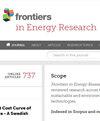Wave energy assessment and wave converter applicability at the Pacific coast of Central America
IF 2.6
4区 工程技术
Q3 ENERGY & FUELS
引用次数: 0
Abstract
Nowadays, numerous governments have instituted diverse regulatory frameworks aimed at fostering the assimilation of sustainable energy sources characterized by reduced environmental footprints. Solar, wind, geothermal, and ocean energies were subject to extensive scrutiny, owing to their ecological merits. However, these sources exhibit pronounced temporal fluctuations. Notably, ocean dynamics offer vast energy reservoirs, with oceanic waves containing significant amounts of energy. In the Central American Pacific context, the exploration of wave energy resources is currently underway. Accurate numerical wave models are required for applied studies such as those focused on the estimation of exploitable wave power; and even more so in Central American region of the Pacific Ocean where existing numerical models simulations have so far relied on coarse resolution and limited validation field data. This work presents a high-resolution unstructured wave hindcast over the Central American Pacific region, implemented using the third-generation spectral wave model WAVEWATCH III over the period between 1979 and 2021. The results of the significant wave height have been bias-corrected on the basis of satellite information spanning 2005 to 2015, and further validation was performed using wave buoy and acoustic Doppler current profiler (ADCP) records located in the nearshore region of the Central America Pacific coast. After correction and validation of the wave hindcast, we employed the dataset for the evaluation and assessment of wave energy and its possible exploitation using different wave energy converters (WECs). This evaluation addressed the need to diverse the energy portfolio within the exclusive economic zones of Guatemala, El Salvador, Honduras, Nicaragua, Costa Rica, Panama, Colombia, and Ecuador in a sustainable manner. Moreover, a comprehensive analysis was carried out on the advantages of harnessing wave energy, juxtaposed with the imperative of regulatory frameworks and the current dearth of economic and environmental guidelines requisite for development within the region.中美洲太平洋沿岸的波浪能评估和波浪转换器的适用性
如今,许多国家的政府都制定了各种监管框架,旨在促进吸收以减少环境足迹为特点的可持续能源。太阳能、风能、地热能和海洋能因其生态优势而受到广泛关注。然而,这些能源具有明显的时间波动性。值得注意的是,海洋动力学提供了巨大的能源储备,海洋波浪蕴含着大量能量。在中美洲太平洋地区,目前正在探索波浪能资源。应用研究需要精确的波浪数值模型,例如那些侧重于估算可开发波浪能的研究;在太平洋中美洲地区更是如此,因为该地区现有的数值模型模拟迄今为止一直依赖于粗糙的分辨率和有限的验证现场数据。这项工作利用第三代频谱波浪模型 WAVEWATCH III 对 1979 年至 2021 年期间的中美洲太平洋地区进行了高分辨率非结构化波浪后报。根据 2005 年至 2015 年的卫星信息对显波高度结果进行了偏差校正,并利用位于中美洲太平洋沿岸近岸区域的波浪浮标和声学多普勒海流剖面仪(ADCP)记录进行了进一步验证。在对波浪后报进行校正和验证后,我们利用该数据集对波浪能及其利用不同波浪能转换器(WECs)的可能性进行了评估和评价。该评估旨在满足危地马拉、萨尔瓦多、洪都拉斯、尼加拉瓜、哥斯达黎加、巴拿马、哥伦比亚和厄瓜多尔等国专属经济区内能源组合多样化的需求。此外,还全面分析了利用波浪能的优势,以及监管框架的必要性和该地区目前缺乏发展所需的经济和环境准则。
本文章由计算机程序翻译,如有差异,请以英文原文为准。
求助全文
约1分钟内获得全文
求助全文
来源期刊

Frontiers in Energy Research
Economics, Econometrics and Finance-Economics and Econometrics
CiteScore
3.90
自引率
11.80%
发文量
1727
审稿时长
12 weeks
期刊介绍:
Frontiers in Energy Research makes use of the unique Frontiers platform for open-access publishing and research networking for scientists, which provides an equal opportunity to seek, share and create knowledge. The mission of Frontiers is to place publishing back in the hands of working scientists and to promote an interactive, fair, and efficient review process. Articles are peer-reviewed according to the Frontiers review guidelines, which evaluate manuscripts on objective editorial criteria
 求助内容:
求助内容: 应助结果提醒方式:
应助结果提醒方式:


